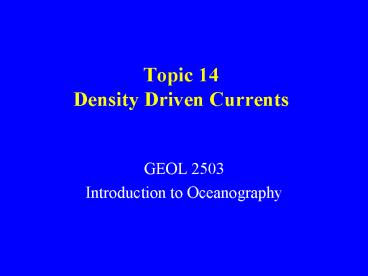Topic 14 Density Driven Currents PowerPoint PPT Presentation
1 / 35
Title: Topic 14 Density Driven Currents
1
Topic 14Density Driven Currents
- GEOL 2503
- Introduction to Oceanography
2
THERMOHALINE CIRCULATION
- VERTICAL circulation driven by DENSITY
- Density of sea water mainly controlled by
temperature and salinity - Temperature is more important
- Warm water has low density, and oceans are heated
from the top. So how does water sink?
3
IMPORTANCE OF VERTICAL CIRCULATION
- DOWNWELLING
- Carries oxygen to the deep ocean
- UPWELLING
- Carries carbon dioxide and nutrients to the
surface
4
Evaporation and Precipitation Patterns
- These zones control evaporation and precipitation
patterns
5
(No Transcript)
6
Evaporation and Precipitation Patterns
- Average ocean salinity is 35
- Tropicsrising airheavy rain
- Oceans lower salinity (34.5 )
- Land tropical rain forests
- 30 NSfalling airevaporation
- Oceans higher salinity (36.7 )
- Land deserts
7
Evaporation and Precipitation Patterns
- 50-60 NSrising air againheavy rain again
- Oceans cool and lower salinity (34.0 )
- Land northern hemisphere forests
8
Another Important Factor
- Polar latitudesseasonal influences
- Wintersea ice formssalinity increases
- Summersea ice meltssalinity decreases
9
Ocean surface salinity
10
Density Controls
- Temperature and Salinity are the major controls
on density of ocean surface water - As salinity increases, density increases
- As salinity decreases, density decreases
- As temperature increases, density decreases
- As temperature decreases, density increases
11
Controls on Salinity
- Increased by
- evaporation
- sea ice formation
- Decreased by
- precipitation
- sea ice melting
- inflow of river water
12
Many combinations of salinities and temperatures
produce the same density
13
Surface Processes
- Less-dense water stays at surface
- Warmer, less saline
- Denser water tends to sink
- Colder, more saline
- The result is a density-layered ocean
14
Changes with Depth
- Well-mixed surface layer to about 100 m
- Increasing density to about 1,000 m
- Constant density below 1,000 m
- Region between 100-1,000 m is called a pycnocline
- Pycno- refers to density
15
Same for Temperature, Salinity
- Thermoclinezone with a rapid change in
temperature with depth - Haloclinezone with a rapid change in salinity
with depth - Pycnoclinezone with a rapid change in density
with depth - All occur between about 100-1,000 m
16
(No Transcript)
17
(No Transcript)
18
(No Transcript)
19
There is no pycnocline (or halocline or
thermocline) in high latitudes because of rapidly
sinking water
20
(No Transcript)
21
Density-Driven Circulation
- Vertical circulation in the oceans is driven by
density - Density is mostly controlled by surface changes
in temperature and salinity - Because of this, vertical circulation is called
thermohaline circulation
22
Upwelling and Downwelling
- Vertical motions of water up or down
- Sinking waterdownwelling
- Rising waterupwelling
- Continuity of flow is basic concept
23
Additional processes cause upwelling and
downwelling
- Surface convergences
- Surface divergences
- Water moving together or apart
- Water moving toward or away from a continent
24
Surface Convergence
- Waters driven together
- Water driven against a continent
- Downwelling occurs
25
Surface Divergence
- Waters driven apart
- Water driven away from a continent
- Upwelling occurs
- Remember the El Niño story
26
(No Transcript)
27
All driven by differences in density
28
Water Masses
- Water with similar temperature and density
characteristics - Acquire characteristics at the surface
- Thermohaline circulation moves masses throughout
the ocean depths - Named by
- Where from
- Where found
29
Water masses
AC Antarctic convergence AD Antarctic
divergence STC subtropical convergence
30
Map view?
Side view?
31
T-S Curves
- Temperature and Salinity (T-S) plotted on graphs
- Remember, water masses have characteristic
patterns of temperature and salinity - So T-S curves delineate water masses
32
(No Transcript)
33
(No Transcript)
34
(No Transcript)
35
(No Transcript)

